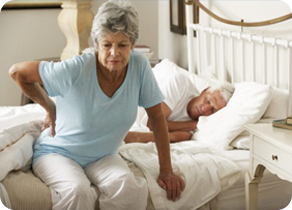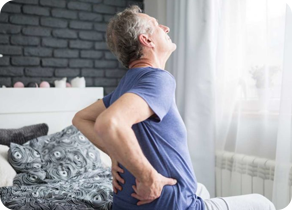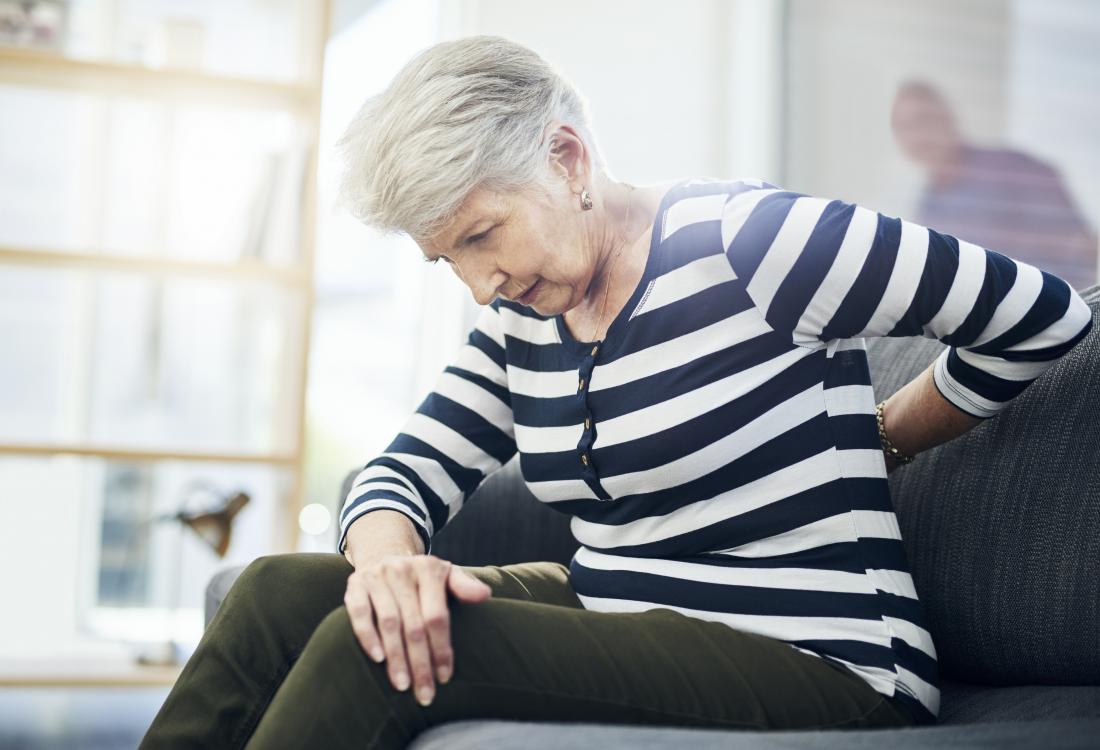Back pain in elderly is almost a certainty, and it can become so debilitating that it feels like it defines you. You become frustrated that you are no longer able to partake in activities you used to enjoy, such as hiking, Yoga, Tai Chi for seniors, playing with your kids or grandkids, or even just going for a walk.
For some, it can become so severe that the pain keeps you from getting routine chores done around the house, or even getting out of bed in the first place due to morning back pain.
Back pain in elderly people can take on so many different forms. This makes pinpointing the root cause of the discomfort and debilitation very difficult. And, it can occur in different areas. For example, one person may experience lower back pain a second may have sciatica pain while another has trouble with upper back pain or middle back pain.
Furthermore, the type of pain can range greatly – from dull, aching pain to sharp, shooting pains. With all these different variables, how do you actually diagnose and fix back pain, and get back to feeling like your old self?
1. What is back pain?
Back pain is one of the most common ailments the elderly face. It is actually responsible for 1 out of every 3 older-aged visits at a physician’s office. With 22% of elderly people (over 65 years of age) reporting back pain on most days, this is clearly an issue.
But, as we mentioned earlier, identifying the root cause of back pain is difficult. And oftentimes, elderly people suffer from multiple types of back pain with multiple causes, creating a tangled medical mess. Before we actually cover the causes of back pain, let’s go over some types and definitions.
We’ll cover some of the most common causes of back pain, and differentiate between different types of back pain. Then, we’ll explain some ways you can start alleviating your discomfort today.
2. Types of back pain
If you were to ask someone what the types of back pain are, they may describe it in two different ways: how long the pain lasts for or the specific location of pain.



2.1. Duration of back pain
- Back pain at its most broad can be broken into three diafferent categories: Acute, subacute, and chronic.
- Acute back pain is characterized as lasting less than 4 weeks. It is usually the result of a small injury which resolves itself. Subacute back pain can last between 4-12 more weeks, and is a bit more serious. It too, however, can be resolved rather quickly in comparison to the third type of back pain.
- Chronic back pain, on the other hand, is characterized as back pain that doesn’t go away, lasting longer than 12 weeks. Many people ask for example “how long does sciatica last?“, but it is never the same answer for everyone. Recurring pain the most common type of back pain in the elderly population, and the trickiest to resolve as you can imagine.
2.2. Location of back pain
- Further complicating matters, back pain can then be broken into location, such as
- lower back pain
- lower right back pain
- middle back pain
- upper back pain
- So in theory, elderly people can suffer from any variation/combination of these types of back pain. From acute lower back pain to chronic middle back pain, one thing is certain: back pain sucks! So what exactly causes it?
3. What causes back pain in elderly people?
One guarantee of aging is that things start to go wrong. Think of your body like a car. If you’re lucky, you get through the first 100,000 miles relatively problem free, with just routine maintenance work and the occasional flat tire.
But, once your car starts crawling into the 125K, 150K and higher mileage ranges, bigger, more costly problems arise.
The same can be said of our bodies. If we take good care of ourselves, it’s likely we won’t experience major health problems.
But after a certain age, you can do everything right and health problems will still arise, just due to old age. The most common of these is back pain.
Your spine ages along with you, and so it makes sense that it could start to degenerate after a certain age. Spine problems are one of the most common causes of pain in the elderly.
Certain factors could exacerbate this and cause your back pain to start sooner than others, such as poor posture, rigorous work, injuries, genetics, etc.
To truly understand why back pain afflicts us as we age, let’s take a detailed look at the back musculature and it’s mechanism.
3.1. Why the back breaks down as we age
- To understand exactly why back pain occurs more frequently in the elderly population, we need to discuss the anatomy of the back. Let’s start by looking at your spine in particular. It features individual bones, which are known as vertebrae. These vertebrae stack on top of each other and connect to one another with small joints, which allow the spine to move.
- Also in our spines, we have disks. These disks are filled with a lubricant and act as “shock absorbers” to prevent individual vertebrae from rubbing against one another.
- As you age, your disks (the shock absorbers) start to wear down and degenerate from years and years of use. This is just a part of aging, and it’s mostly inevitable.
- But, this rubbing of the vertebrae against one another closer and closer as the disk diminishes is where most of the pain in your back originates from. This is the most common cause of back pain, and is referred to as degeneration of disks. This process of deterioration in our back opens the door for tons of other
3.2. Common back conditions that cause pain in elderly
- There are a few common causes of back pain in those over 50 years of age. There are plenty more than just what we’ll discuss here, but these are the most common that elderly people deal with on a daily basis.
Spinal stenosis
- Spinal stenosis is a condition where the area around your spine diminishes. In other words, organs and muscles surround your back start to shrink up.
- This leads to a decrease in your spinal canal, and can cause pinching of the spinal cord or nerves. This can be some of the most painful sensations you’ve ever experienced, and can lead to more than just pain. Watch for tingling, numbness, or headaches as a result of Spinal stenosis.
Spondylolisthesis
- Spondylolisthesis is a disease that affects your lower vertebrae. It causes your vertebrae to slip onto the bone directly under it, causing excruciating pain.
- This particular condition is rather treatable, but if not corrected quickly, can cause irreversible damage.
- Each of these conditions has different symptoms, causes, and treatments, but they all boil down to the same thing: changes in your spine due to age. So, should you just accept that you aren’t the person you once were, and accept your immobile, painful existence?
- No, all is not lost. There are plenty of ways you can alleviate your back pain in elderly years. From simply getting out and moving a bit every day to starting regular acupuncture, we’ll cover them all.
4. How To Alleviate Back Pain In Elderly People
The common conditions that lead to back pain in elderly people cause inflammatory or pressure related pain in your nerves. If you know your specific back condition, whether it be arthritis or spinal stenosis, you can come up with a specific treatment plan to tackle that type of back pain
With that in mind, here are some ways you can decrease general inflammation and pressure in your back, and therefore, decrease your back pain.
4.1. Home remedies for back pain in old age
- There are a few home remedies you can try to alleviate your back pain with. Sometimes, these are your only options. Luckily however, these simple methods will help the vast majority of people suffering from back pain.
Become more physically active
- While it can feel impossible to get outside and take a walk, or hop in the pool at your local gym, getting your blood flowing to all areas of your body is one of the easiest and most effective ways to decrease back pain in elderly people.
- The most important muscle to strengthen to alleviate back pain in the elderly is the core. Instable, weak cores are often the culprit for many types of back pain, and so do your planks, or find other low impact exercises that you can do!
- You should also start stretching, as often times its tight muscles that contribute to back pain in old age. In particular, tight hamstrings, glutes, and chest/shoulder muscles can all contribute to back pain.
Stretching
- Upper back stretches for pain
- Mid back stretches
- Lower back stretches for older adults
- Sciatic nerve stretches
Medications to treat back pain in elderly
- One of the more notorious ways people try and cure their back pain is with NSAIDs or other medications. But, the reality is that these mostly are just masking symptoms of your back pain.
- Ibuprofen, Tylenol, Aspirin, and stronger drugs are not a long term solution to fixing back pain, and should be used sparingly to treat only the most agonizing back pain outbreaks.
- If you wake up one morning and your back is killing, sure, take some over the counter meds. But, don’t make it a daily habit, or it can turn into a dependency.
Heating & cooling your back
- Alternating between cooling and heating your back can help alleviate swelling and inflammation in your back, but only when used correctly.
- When first dealing with back pain, start with 20 minutes of ice a few times a day for 2-3 days. This will quiet painful inflammations or spasms you may experience.
- Then, switch to using a heating pad on your back, or even take warm baths to further decrease pain. Heating your back will get blood moving, similar to exercise.
- After heating your muscles, you can stretch them to prevent muscle spasms and decrease pain later on.
4.2. Professional treatment options for managing back pain in elderly
- If you have free time and good insurance, and your back pain doesn’t improve after a few weeks of home remedies, you may need to seek professional treatment.
- There are quite a few different types of professional care that can help you, including physical therapy, acupuncture, and chiropractic care.
Physical therapy
- A physical therapist can help diagnose the root cause of your back pain, and help you undergo a treatment plan to restore balance to your back.
- Physical therapy is a combination of massage, stretching, and exercising to fix imbalances that cause pain, and strengthen areas that are causing pain due to
Acupuncture
- This unique healing practice involves sticking fine needles into certain points of your back to manipulate them. While it sounds painful, it actually is incredibly therapeutic, and can do wonders for back pain in elderly folks.
- The needles stimulate the healing process, and can be a great way to seek relief if any of the aforementioned healing practices don’t help.
Chiropractic care
- Another more advanced form of back pain therapy for elderly is seeing a chiropractor. This is a controversial topic, as some swear by chiropractic care while others call it a sham.
- Also referred to as osteopathic doctors, these specialists use their hands and weight to move, adjust, and mobilize your spine. IF you’ve never given it a try and you’re a generally open minded person, look into it!
5. Should I get surgery to treat my back pain?
If you’ve seen a doctor for your age related back pain, there is a good chance the conversation of surgery came up.
The reality is, surgery isn’t a good option for most people, but especially for elderly. The recovery is very tough, and the success rates are low. Often times, back surgery ends up causing more problems than it fixes.
Not to mention, back surgery is incredibly expensive. While it varies greatly on the type of surgery, the average back surgery costs over $100,000.
